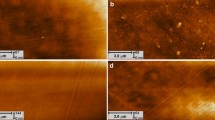Abstract
The role of different cell surface components in the adhesion ofStreptococcus pyogenes to pharyngeal cells was investigated. No difference between parental strains and Mnegative mutants in adhesiveness was detected. Purified lipoteichoic acid markedly inhibited adhesion of group A streptococci. A similar inhibitory effect was observed with group B streptococci andStaphylococcus, aureus strains. All the A-variant streptococci tested demonstrated decreased adhesion ability. In particular, the A-486 strain, with a temperaturedependent variation in the synthesis of the group-specific carbohydrate, adhered less when cultured at nonpermissive temperature (38°C). No effect of growth temperature on lipoteichoic acid synthesis was detected. Preincubation of epithelial cells with group-A-specific polysaccharide greatly decreased the number of bacteria per cell that adhered. These results suggest that C polysaccharide might be specifically involved in the adhesion of group A streptococci.
Similar content being viewed by others
Literature Cited
Alkan, M., Ofek, I., Beachey, E. H. 1977. Adherence of pharyngeal and skin strains of group A streptococci to human skin and oral epithelial cells. Infection and Immunity18:555–557.
Anthony, B. F., Okada, D. M. 1977. The emergence of group B streptococci infections of the newborn infant. Annual Review of Medicine28:355–369.
Ayoub, E. M. 1978. Temperature-dependent variation in the synthesis of streptococcal group-specific carbohydrate. II. Biosynthetic studies in group A and variant strains. Journal of Bacteriology134:574–584.
Bartelt, M. A., Duncan, J. L. 1978. Adherence of group A streptococci to human epithelial cells. Infection and Immunity20:200–208.
Botta, G. A. 1979. Hormonal and type dependent adhesion of group B streptococci to human vaginal cells. Infection and Immunity25:1084–1086.
Botta, G. A., Soro, O., Romanzi, C. A. 1978. Evaluation of laboratory methods for the detection of antistreptococcal antibodies. In: Parket, M. T. (ed.), Pathogenic streptococci. Chertsey, England: Reedbooks.
Cleary, P. P., Johnson, Z. 1977. Possible dual function of M protein resistance to bacteriophage A25 and resistance to phagocytosis by human leucocytes. Infection and Immunity16:280–292.
Crowe, C. C., Sanders, W. E., Jr., Lougley, S. 1973. Bacterial interference II. Role of the normal throat flora in prevention of colonization of group AStreptococcus. Journal of Infectious Diseases128:527–552.
Cunningham, M., Beachey, E. H. 1975. Immunochemical properties of streptococcal M protein purified by isoelectrofocusing. Journal of Immunology115:1002–1010.
De Marzo, D., Botta, G. A. 1979. Impaired adhesiveness of group A-variant streptococci to oral epithelial cells, pp. 787–788. In: Nelson, J. D., Grassi, C. (eds.), Current chemotherapy and infectious diseases. Washington, D. C.: American Society for Microbiology.
Ellen, R. P., Gibbons, R. J. 1974. Parameters affecting the adherence and tissue tropism ofStreptococcus pyogenes. Infection and Immunity9:85–91.
Gibbons, R. J. 1977. Adherence of bacteria to host tissue, pp. 395–406. In: Schlessinger D. (ed.), Microbiology-1977. Washington, D. C.: American Society for Microbiology.
Lancefield, R. C. (1928) The antigenic complex ofStreptococcus haemolyticus. I. Demonstration of a type specific substance in extracts ofStreptococcus haemolyticus Journal of Experimental Medicine47:91–103.
McCarty, M. 1952. The lysis of group A haemolytic streptococci by extracellular enzymes ofStreptomyces albus. II. Nature of the cellular substrate attacked by the lytic enzymes. Journal of Experimental Medicine96:569–580.
McCarty, M. 1955. Variation in the group specific carbohydrate of group A streptococci. I. Immunochemical studies on the carbohydrate of variant strains. Journal of Experimental Medicine102:11–28.
Ofek, I., Beachey, E. H., Jefferson, W., Campbell, G. L. 1975. Cell membrane binding properties of group A streptococcal lipoteichoic acid. Journal of Experimental Medicine141:990–1003.
Selinger D. S., Neil, J., Reed, W. P., Williams, R. C., Jr. 1978. Adherence of group A streptococci to pharyngeal cells: A role in the pathogenesis of rheumatic fever. Science201:455–456.
Author information
Authors and Affiliations
Rights and permissions
About this article
Cite this article
Botta, G.A. Surface components in adhesion of group a streptococci to pharyngeal epithelial cells. Current Microbiology 6, 101–104 (1981). https://doi.org/10.1007/BF01569012
Issue Date:
DOI: https://doi.org/10.1007/BF01569012




